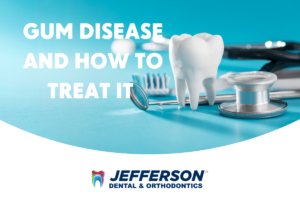
Written Yesenia Santos – Hygiene Manager at Jefferson Dental & Orthodontics
According to the American Dental Hygiene Association, approximately 80% of American adults have periodontal disease. Could you be one of them? Let’s talk gum disease and how to treat it!
Types of Gum Disease
There are two types of periodontal disease (gum disease): gingivitis and periodontitis. When plaque–filled bacteria are not adequately removed from the surfaces of your teeth, it can cause gingivitis. However, gingivitis is reversible with good oral hygiene and regular checkups.
Early Signs of Gum Disease:
- Bleeding upon brushing or flossing
- Red, swollen gums
- Tenderness of the gums
If left untreated, gingivitis can lead to a more severe type of gum disease: periodontitis. Periodontitis is an irreversible infection that affects the gums and jawbone, ultimately increasing your risk for tooth loss. Periodontal disease is detected with a periodontal probe, or “dental ruler,” that measures the depth of the pockets between your teeth and gums. Periodontitis causes the gum layer to pull away from the teeth and form a pocket. These pockets collect debris and bacteria that lead to infection, ultimately destroying the supporting structures of our teeth. What starts off as a simple case of plaque growth can eventually lead to painful and costly tooth loss if left untreated.
When To Visit the Hygienist More Often
Firstly, we recommend that you visit your dental hygienist for a regular dental cleaning twice a year. However, some may need to visit sooner or more often, especially those who fall into any of the following categories:
- Diabetes
- Pregnancy
- Patients undergoing orthodontic treatment
- Patients already diagnosed with gum disease
- Limited dexterity
To clarify, a regular cleaning isn’t enough to treat periodontal disease.
Periodontitis Treatment
Do not worry! Your highly–trained dental hygienist is equipped with the latest tools and techniques to properly treat your periodontal disease. Scaling and root planing, or “deep cleaning”, in addition to irrigation and a product called Arestin, will help you get right back on track.
What is Scaling and Root Planing?
The goal of a scaling and root planing procedure is for your dental hygienist to remove bacteria, plaque and calculus (otherwise known as tartar) that you, cannot physically remove on your own. Dental hygienists use specialized tools to reach down into the pockets and achieve this. However, when doing this procedure, our instruments can only reach so far. We then proceed with irrigation to deliver an antibacterial solution to clean out and reduce bacterial pathogens. Lastly, we place Arestin at the site of infection to reduce the pocket depth.
What is Arestin?
So what is Arestin? Arestin (minocycline hydrochloride) is an antibiotic in the form of microspheres delivered locally into areas of concern (areas with gum disease) by your dental professionals. This is used in conjunction with scaling and root planing to target bacteria that our tools cannot reach. Consequently, Arestin will help control the progression of periodontal disease.
Who can benefit from Arestin?
Anyone who has periodontitis! If you have been diagnosed with with periodontitis, don’t worry! This may be just what you need to help you get back on track to a healthy, happy smile. The only patients who cannot receive this antibiotic are patients who are allergic to tetracycline or who are pregnant or nursing.
Is it time for your next dental cleaning? Schedule a check-up with the dental hygienist at your local Jefferson Dental & Orthodontics today! It’s easy to do—to get started, book an appointment online.




